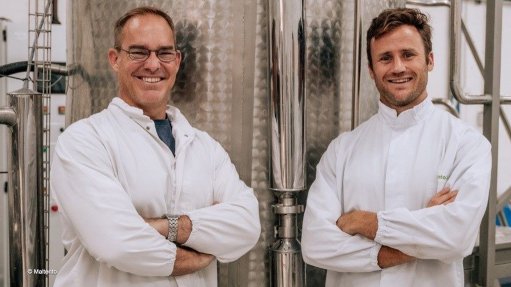Nuclear medicine industry affected by Covid-19


GOING NUCLEAR The SASNM hosts regional theranostic clubs to keep its members up to date with nuclear medicine happenings
The Covid-19 pandemic has caused a drop of over 50% in services rendered in the nuclear medicine industry which has also led to unemployment and facilities closing down, says South African Society of Nuclear Medicine (SASNM) immediate past president Dr Moshe Modiselle.
Current SASNM president Dr Stuart More further explains that the pandemic caused patients to develop new diseases that had to be treated and studied, some of which required nuclear medicine techniques to aid in the diagnosis of these entities.
Modiselle embarked on an international study of the impacts of the pandemic in the nuclear medicine industry in 2020 for the Journal of Nuclear Medicine. The study revealed an average decrease of about 36% in positron emission tomography/ computed tomography (PET/CT) scans and declining diagnostic procedures at the start of the pandemic.
Further, the nuclear medicine industry faces regulatory challenges regarding locally produced nuclear medicines.
While some raw isotopes are being produced in South Africa, regulatory issues can delay administering such products in the country and negatively affect scheduling procedures for patients.
However, regulatory measures are necessary to uphold good clinical management ethics and standards.
Additionally, the industry faces human resource challenges, owing to the country’s large population and lack of PET/CT and nuclear medicine and molecular imaging facilities to administer relevant radioisotopes.
A lack of specialists, such as medical physicists and radio pharmacists, is further hampering the industry and, owing to a lack of resources, the bulk of nuclear medicine research is isolated to academic research centres.
However, More says nuclear medicine should be available in district hospitals to allow for job creation and the training of specialists, such as physicians and radio pharmacists, wanting to work in the field.
Moreover, Modiselle says there is an imbalance of nuclear medicine facilities in South Africa, with 13 nuclear medicine facilities in the public sector and 46 facilities in the private sector.
This imbalance means people living in rural areas of the country do not have adequate access to nuclear medicine services, including diagnostic imaging and treatments offered.
He adds that, while more facilities should be made available in State hospitals to reduce the workload of academic institutions, this requires funding and feasibility studies to explain the benefits of having a nuclear facility in hospitals.
“Young physicians are willing to work and expand the nuclear medicine industry to areas where there is no access to it. However, there is no opportunity for them to do so,” adds More.
DEVELOPMENTS
While the nuclear medicine industry faces challenges, more public facilities have been established, such as in Klerksdorp, in the North West.
Research and infrastructure in the local nuclear medicine industry is expanding, with more machines coming into the country for State hospitals and private facilities, with greater production of radioisotopes and cyclotrons.
More explains that nuclear medicine allows for a better patient prognosis than anatomical imaging by predicting, for example, whether somebody is at risk of a cardiovascular event that may cause damage to the heart muscle.
Nuclear medicine is also beneficial for treating neuroendocrine tumours and prostate cancer for those who qualify for the treatment.
Further, Modiselle says the VISION trial, published last year, demonstrated that Lutetium 177 prostate specific membrane antigen therapy can be safely used in metastatic castration-resistance prostate cancer patients.
The trial aimed to provide evidence that this treatment can be used in combination with standard of care to prolong overall survival and progression free survival in patients with advanced prostate cancer.
The therapy received approval from US federal agency the Food and Drug Administration.
However, Modiselle says this treatment is costly and can, consequently, be difficult to administer to patients from low to medium income countries.
There have also been developments in infection and cancer imaging to benefit neurology, cardiology and oncology.
More recently, the Nuclear Medicine Research Infrastructure, part of the Department of Science and Innovation’s South African Research Infrastructure Roadmap, is a local facility dedicated to conducting preclinical and clinical research related to nuclear medicine, molecular imaging and radionuclide therapy in South Africa to assist with these developments in imaging and therapy.
EDUCATION INITIATIVES
The SASNM aims to provide access to information and the tools necessary to improve the practice of nuclear medicine, medical imaging and theranostics in South Africa to keep its members well-informed on what is going on in the industry.
Modiselle says the society also aims to standardise theranostic training on a global scale to enable local nuclear physicians to use universal nuclear diagnostic and therapeutic services.
Further, the society aims to engage with relevant stakeholders to mitigate issues that arise in daily care management.
More adds that educating people on the benefits of nuclear medicine will be advantageous for the industry in the long term.
As a result, the society has engaged in education initiatives in the form of online webinars, symposia and a newsletter to educate attendees and readers on the benefits of nuclear medicine.
The SASNM also hosts regional theranostic clubs to galvanise greater context for society members and those who are part of allied disciplines to keep them up to date with nuclear medicine happenings.
The clubs aim to encourage interaction between specialists and colleagues to allow for a multidisciplinary approach when treating patients, considering theranostics is novel to the nuclear medicine industry.
New developments occur regularly in theranostics regarding the treatment of diseases such as prostate cancer and neuroendocrine disease.
The next theranostics club meeting will be held on May 18 in Cape Town.
The Masterclass on neuroendocrine tumours and prostate cancer will also be held in Cape Town on 26 and 27 August.
The 20th SASNM Congress will take place in Gqeberha in August next year.
Comments
Press Office
Announcements
What's On
Subscribe to improve your user experience...
Option 1 (equivalent of R125 a month):
Receive a weekly copy of Creamer Media's Engineering News & Mining Weekly magazine
(print copy for those in South Africa and e-magazine for those outside of South Africa)
Receive daily email newsletters
Access to full search results
Access archive of magazine back copies
Access to Projects in Progress
Access to ONE Research Report of your choice in PDF format
Option 2 (equivalent of R375 a month):
All benefits from Option 1
PLUS
Access to Creamer Media's Research Channel Africa for ALL Research Reports, in PDF format, on various industrial and mining sectors
including Electricity; Water; Energy Transition; Hydrogen; Roads, Rail and Ports; Coal; Gold; Platinum; Battery Metals; etc.
Already a subscriber?
Forgotten your password?
Receive weekly copy of Creamer Media's Engineering News & Mining Weekly magazine (print copy for those in South Africa and e-magazine for those outside of South Africa)
➕
Recieve daily email newsletters
➕
Access to full search results
➕
Access archive of magazine back copies
➕
Access to Projects in Progress
➕
Access to ONE Research Report of your choice in PDF format
RESEARCH CHANNEL AFRICA
R4500 (equivalent of R375 a month)
SUBSCRIBEAll benefits from Option 1
➕
Access to Creamer Media's Research Channel Africa for ALL Research Reports on various industrial and mining sectors, in PDF format, including on:
Electricity
➕
Water
➕
Energy Transition
➕
Hydrogen
➕
Roads, Rail and Ports
➕
Coal
➕
Gold
➕
Platinum
➕
Battery Metals
➕
etc.
Receive all benefits from Option 1 or Option 2 delivered to numerous people at your company
➕
Multiple User names and Passwords for simultaneous log-ins
➕
Intranet integration access to all in your organisation



















